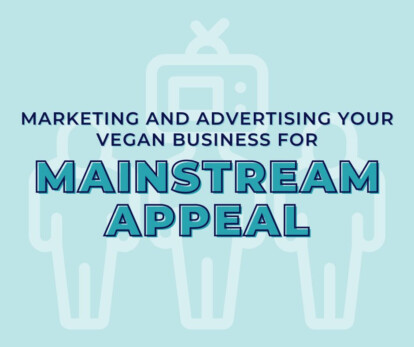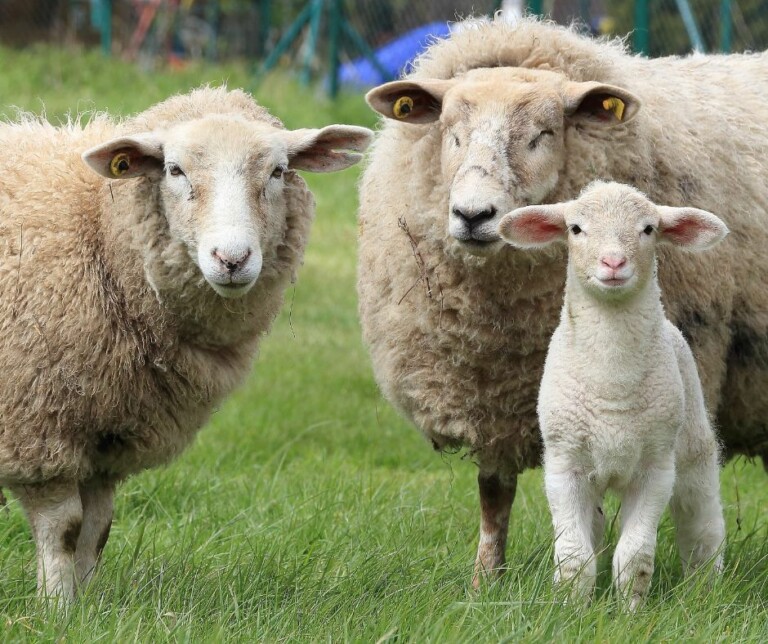Marketing and advertising for mainstream appeal as a vegan business


There are many reasons why the mainstream fashion industry is problematic. Use of resources, poor working conditions, pollution, and greenhouse gases are just some of the pressing concerns. But other animals pay the price of human fashions too. Indeed, fashion claims billions of non-human victims every single year.
How are other animals used within the fashion industry? What can we do as ethical consumers? What are the big issues?
Let’s take a look.
One of the most notorious aspects of exploitation in the fashion industry is the use of fur and skins from other animals.
It’s estimated that over 100 million non-human animals are slaughtered every single year, including minks, foxes, chinchillas, rabbits, and snakes who are often bred and killed solely for their fur or skin.
The fur industry faces significant criticism for its cruel practices, including confinement in small cages with no opportunity to express natural behaviours and inhumane killing methods (such as electrocution, neck-breaking or gas chambers).
Growing awareness about the ugly realities of so-called “fur farming” – a term that sanitises the suffering involved – means that the use of real fur by the fashion industry has become increasingly controversial in recent years.
That being said, some major fashion brands still use fur and skin in their products. There are petitions to urge Dior and Louis Vuitton, for example, to change their practices.
Thankfully, some fashion brands and designers have recognised the ethical concerns surrounding fur production and have chosen to go fur-free. Luxury brands like Armani, Chanel, Gucci, Versace, Michael Kors, Burberry, and Prada have made public commitments to stop using fur in their collections. This trend has been further reinforced by growing consumer demand for cruelty-free and vegan fashion options.
Stella McCartney, who launched her brand in 2001, has never used fur, leather, feathers or skin in her designs (she does, however, use wool – see more about why this is problematic below). Calvin Klein was one of the early adopters of fur-free fashion, banning fur from his designs in 1994.
Despite some positive developments, the fur industry persists in certain regions and countries, particularly in places with less stringent animal welfare regulations. Some niche markets and high-end fashion segments still cater to consumers who desire fur products.
The public holds the power here. While there’s a market for fur products, our animal kin will continue to be exploited for their pelts. As ethical consumers, we have to show that there’s no demand.
We mustn’t overlook the market for so-called “exotic” skins, such as those from snakes, alligators, and crocodiles. The production of exotic skins involves capturing and killing reptiles or breeding them in captivity under often inhumane conditions.
Some biodiversity experts even argue for the trade of reptile skin, stating that it helps conservation efforts because people have an incentive to protect the animals and their habitats to safeguard their profits. They also argue that the species are not those at risk of extinction.
Of course, none of these arguments recognises the sentience or rights of the individual reptiles. Numerous research studies conclude that reptiles are capable of experiencing anxiety, distress, excitement, fear, frustration, pain, stress, and suffering.
These animals are often skinned alive after living in cramped, unsanitary conditions that don’t even meet their basic needs.
Currently, the global leather industry is booming, with an estimated value of $420 billion. In addition to clothes, shoes and accessories, people see leather as a premium material for car interiors, sports equipment and other luxury goods.
What buyers don’t necessarily realise or want to look at too closely is that the leather industry contributes to the exploitation of animals, mainly cows, but also sheep, pigs, and other animals. It’s estimated that a staggering one billion animals are slaughtered every year within the leather industry.
People often think of leather as being a by-product of farming other animals for their flesh. Surely, they reason, it’s better to use as much as possible of an animal who has been slaughtered to ensure value comes from their death rather than letting any by-products go to waste.
In reality, though, leather is a co-product of animal agriculture, adding directly to the number of animals slaughtered each year.
Cows are often subjected to intensive farming, as well as – in some parts of the world – unethical practices such as tail docking, dehorning, and castration without anaesthesia.
The farming of cows for their skin and flesh also contributes to deforestation and biodiversity loss, as vast areas of land are cleared for grazing and the production of animal feed. In addition, tanneries require a constant supply of water and can cause severe water pollution, leading to unfettered ecological damage to waterways and the life within them.
While wool is often considered a natural and sustainable material, there are ethical concerns associated with the wool industry, not least that sheep are being kept and exploited for human purposes.
Stella McCartney, who is often held up as an example of a fashion brand that does not use fur or skin does still feature wool in her designs. On her website, she discusses the ethical issues this poses and the work taking place across the brand in this area, including making use of recycled wool and using fully traceable ‘ethical’ supply chains.
But can using wool ever be truly ethical?
Even in the ‘best’ of conditions where welfare is prioritised, shearing is a stressful process for sheep, from being rounded up to penned.
Farmed sheep have been bred to overproduce wool rather than shedding naturally. This makes them prone to overheating and matting, while ensuring they have to be sheared regularly.
Sheep used for wool sometimes endure painful procedures like mulesing – this is where chunks of skin are cut off without anaesthesia to create scar tissue that is less prone to flystrike. Lambs that undergo this procedure will, according to the RSPCA Australia, “socialise less, lose weight in the first two weeks post mulesing, (and) exhibit behavioural indicators of pain including prolonged hunched standing and less time lying and feeding”.
Currently, mulesing is only legal in Australia with other countries having abandoned the practice or made it illegal. But one country is enough as Australia supplies 75% of the world’s apparel wool.
In other parts of the world, the industry is criticised for the poor treatment of sheep, including overcrowded and unsanitary conditions.
Shearers are often paid by volume rather than for their time, which encourages them to handle sheep roughly for speed, not the individual animal’s comfort. And because sheep are prey animals who have a strong flight instinct when threatened, shearers may use force to ensure compliance during the shearing process.
There is undercover footage – some as recent as 2020 – of sheep being kicked, punched, knelt on, hit with electric clippers, or physically maimed to force them into submission.

The sheep’s wool industry is bad for the environment too. Around 95% of all wool comes from global mass production, which uses a vast amount of resources, most notably land and water. In turn, this leads to soil erosion, biodiversity loss and increased greenhouse gas emissions due to methane produced by sheep’s digestive systems.
Sheep tend to be heavily treated with chemicals to keep them free from parasites. This can pollute the soil, air, water and surrounding ecosystems.
Wool doesn’t just come from sheep; it can come from goats, muskox, camelids (such as alpaca), and rabbits too.
Undercover investigations have shown angora rabbits suffering agony as their fur was plucked from them while they were still alive at angora wool farms in China.
Male angora rabbits are often slaughtered at birth because they yield less fur than females and are, therefore, less profitable for breeders. Even females tend to be inhumanely killed at age two or three years when their fur growth starts to deplete. Longer hair is worth more, which profits workers to pluck the fur rather than shear it.
Down (the soft, fluffy feathers that cover young birds or sit under the exterior feathers of older birds) is frequently used in clothing, particularly in jackets and bedding. This is because down provides padding and insulation for birds, and these qualities are desirable in items for humans designed to provide warmth.
However, the sourcing of down raises concerns about the ethical treatment of geese and ducks. Many birds used for down production are subjected to live plucking, which is a painful and distressing process that can cause skin tears, lasting pain, behavioural changes, and even death.
There is what’s known as a “Responsible Down Standard”, which is meant to ensure that no live birds are plucked, but reports suggest that live plucking still happens in some accredited facilities.
As with leather, down and feathers are a co-product of the meat industry. Current figures show that 3.3 billion ducks are slaughtered every year globally (that’s nine million a day).
Silk is another animal-derived material that supplies a multi-billion dollar industry. It’s produced from fibre spun by the larva (caterpillars) of the silk moth – referred to as “silkworms” – when they make their cocoons to metamorphose from caterpillar to moth.
If the silkworms are left to exit their cocoons naturally, they produce an acidic liquid to burn a small hole in the silk structure to make their escape. As this process damages the silk, humans intervene while the silkworm is still in its pupal state, submerging the cocoon in boiling water to unravel and extract the silk in a single thread – and boiling the silkworms alive.
Billions of silkworms die in this way every single year.
Although there is an ongoing debate about the extent to which invertebrates such as moths can feel pain, the evidence would suggest they can.
Beyond materials, the fashion industry also involves the use of other animals in testing and the inclusion of animal-derived ingredients. Cosmetics and personal care products may be tested on animals, and some clothing items may contain animal-derived components like silk or certain dyes made from insects.
The fashion industry’s emphasis on fast fashion and the constant demand for new trends contribute to overconsumption and waste. This perpetuates a cycle of animal exploitation and environmental degradation, as it requires more resources – including land, the loss of which can impact species not directly used by the fashion industry – and leads to the disposal of large quantities of clothing, including those made from animal-derived materials.
There’s no doubt that public opinion is shifting away from the use of animal-derived products in fashion.
Buying cruelty-free fashion is a choice we can all make and, with that choice, send a message that exploiting our animal kin doesn’t pay. But it isn’t enough to avoid purchasing animal-based materials. We have to choose alternatives that are sustainable and environmentally friendly too. Many synthetic materials, for example, require the heavy use of natural resources and energy and contribute to devastating pollution that impacts all life on Earth.
Designers and fashion brands need to be encouraged to innovate and prioritise sustainability, as well as promise the end of animal exploitation for appearances and profit. It isn’t enough to replace real fur with fake fur. Instead, we need to show that there’s a demand for sustainable, cruelty-free materials and for consuming less or reusing more.